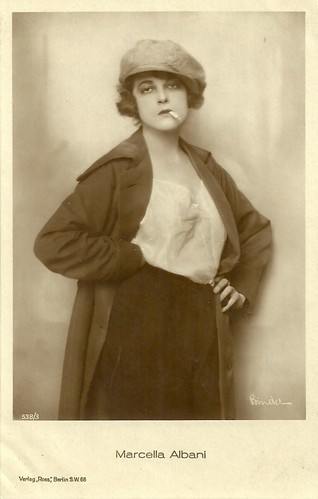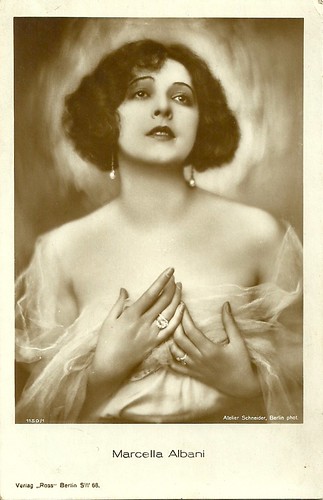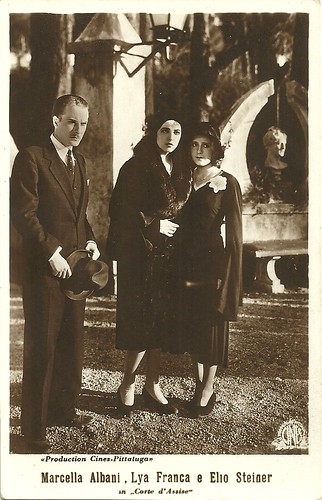
German postcard by Ross Verlag, Berlin, no. 596/3, 1925-1926. Photo: Albani Film. Marcella Albani in Die Flucht in den Zirkus/The Circus of Life (Mario Bonnard, Guido Schamberg aka Guido Parish, 1926). Collection: Didier Hanson.

German postcard by Ross Verlag, Berlin, no. 596/4, 1919-1924. Photo: Albani-Film.

German postcard by Ross Verlag, Berlin, no. 840/1, 1925-1926. Photo: Alex Binder / Albani-Film.

German postcard by Ross Verlag, Berlin, no. 840/3, 1925-1926. Photo: Alex Binder / Albani-Film.

German postcard by Ross Verlag, Berlin, no. 1521/1, 1927-1928. Photo: Aafa Film.

German postcard by Ross Verlag, Berlin, no. 1750/3, 1926. Photo: Atelier Schneider, Berlin. Collection: Didier Hanson.

German postcard by Ross Verlag, no. 3704/2. Photo: Atelier Ernst Schneider. Marcella Albani in Der Kampf ums Matterhorn/Fight for the Matterhorn (Mario Bonnard, Nunzio Malasomma, 1928) in which Albani plays the wife of the protagonist Luis Trenker and wears the same shawl.
Ambrosio
Marcella Albani was born as Ida Maranca in the village of Albano Laziale near Rome, in 1899. Her father was the owner of a popular hosteria in Trastevere.
Shortly after finishing grammar school, she met the Roman aristocrat Guido Parish. The actor-director gave her the stage name Marcella Albani and directed her in her first film, L'amplesso della morte/The Embrace of the Dead (Guido Parish, 1919).
For Ambrosio Film in Turin, they made a series of melodramas and adventure films, including Salvator (1920), La figlia delle onde/The Daughter of the Waves (1921), Amore in fuga/Love on the Run (1921), and Bufera/Buffalo (1922).
Sadly in 1922, the legendary Ambrosio film company went bankrupt, and Parish had to sell out their films.

German postcard by Ross Verlag, Berlin, no. 240/4, 1919-1924. Photo: Alex Binder / Albani Film.

German postcard by Ross Verlag, Berlin, no. 538/1, 1919-1924. Photo: Alex Binder.

German postcard by Ross Verlag, Berlin, no. 538/2, 1919-1924. Photo: Alex Binder.

German postcard by Ross Verlag, Berlin, no. 538/3, 1919-1924. Photo: Alex Binder. Marcella Albani in Das Spiel der Liebe/The Game of Love (Guido Parish, 1924).

German postcard by Ross Verlag, Berlin, no. 892/1, 1925-1926. Photo: Alex Binder / Albani-Film.

German postcard by Ross Verlag, Berlin, no. 892/2, 1925-1926. Photo: Alex Binder / Albani Film.

German postcard by Ross Verlag, Berlin, no. 1021/1, 1927-1928. Photo: Alex Binder.

German postcard by Ross Verlag, Berlin, no. 1021/2, 1927-1928. Photo: Alex Binder.

German postcard by Ross Verlag, Berlin, no. 1150/1, 1927-1928. Photo: Atelier Schneider, Berlin.

German postcard by Ross Verlag, Berlin, no. 1150/2, 1927-1928. Photo Atelier Schneider, Berlin.

German postcard by Ross Verlag, Berlin, no. 1150/4, 1927-1928. Photo: Atelier Schneider / Albani-Film.
Absolute Peak in Popularity
In 1923 Marcella Albani and Guido Parish went to Berlin. In 1923 she appeared in Frauenschicksal/Woman's Destiny (Guido Schamberg, 1923) and Im Rausche der Leidenschaft/In the intoxication of passion (Guido Schamberg, 1923) with Alfred Abel.
Marcella was an instant success in Germany. Other films were Das Spiel der Liebe/The Game of Love (1924) with Alfred Abel, Guillotine (1924) with Willy Fritsch, and Die Flucht in den Zirkus/The Circus of Life (1926) with Vladimir Gajdarov, which she made with her own company Marcella Albani Film GmbH, and which were directed by Guido Parish under the pseudonym Guido Schamberg.
During this period she portrayed mainly elegant Latin beauties. In 1926, her cooperation with Parish ended and she went on to make films with famous directors like Joe May and Friedrich Zelnik.
Albani experienced her absolute peak in popularity between 1927 and 1929 when she made twenty films within three years. These included Das Geheimnis des Abbe X/Behind the Altar (Julius Brandt, Wilhelm Dieterle, 1927) and Fürst oder Clown/Prince or Clown (Aleksandr Razumnyj, 1928) with Iván Petrovich.
Her engagements led her to France for L’évadée/The Escapist (Henri Ménessier, 1928), Austria for Das Weib am Kreuze/The Female at the Cross (Guido Brignone, 1929), Czechoslovakia for Hricy Lasky/The Last Mask (Carl Lamac, 1930) and to Italy for Corte d'Assise/Before the Jury (Guido Brignone, 1931).

Probably a French postcard, editor unknown. Strangely enough, the name is spelled Albania here. Written on the back: Marcella Albani, 1926.

French postcard by Europe, no. 185. Marcella Albani in Die Flucht in den Zirkus/The Circus of Life (Mario Bonnard, Guido Schamberg aka Guido Parish, 1926). Albani plays a snake charmer performing in a Salome-like attire in a circus.

French postcard by Europe, no. 511. Photo: Loca Films.

French postcard by Europe, no. 575. Photo: Mercure Film.

French postcard by Europe, no. 576. Photo: Mercure Film.

Austrian postcard by Iris Verlag, no. 814. Photo: Sascha. Marcella Albani in Dagfin (Joe May, 1926).

Austrian postcard by Iris-Verlag, Berlin, no. 5346. Photo: Norbert & Co. / HOM. Marcella Albani in Der Kampf ums Matterhorn/Fight for the Matterhorn (Mario Bonnard, Nunzio Malasomma, 1928) in which Albani plays the wife of the protagonist Luis Trenker and wears a similar shawl.

German postcard by Ross Verlag, no. 1450/1, 1927-1928. Photo: Ernst Schneider, Berlin.

German postcard by Ross Verlag, no. 1931/1, 1927-1928. Photo: Alex Binder, Berlin.

German postcard by Ross Verlag, no. 3170/1, 1928-1929. Photo: Atelier Schneider.

German postcard by Ross Verlag, no. 3278/1, 1928-1929. Photo: Atelier Bieber, Berlin.
Coppa Volpi
After the advance of sound film, Marcella Albani turned to writing. She published novels like 'Glauca, l'amata l'innamorata' (Glauce, the Beloved Lover) and 'La Citta dell' Amore'(The City of Love). The latter was adapted for the screen with her by director Mario Franchini, La Citta dell' Amore/The City of Love (1934).
Since 1931 Franchini was also her husband, with whom she had a child. Incidentally she made films like Stradivarius (Albert Valentin, Géza von Bolváry, 1935) with Pierre Richard-Willm and Edwige Feuillère, and the German language version, Stradivari (Géza von Bolváry, 1935) with Gustav Fröhlich and Sybille Schmitz.
Her last film was the German Western Der Kaiser von Kalifornien/The Emperor of California (Luis Trenker, 1936) starring director Luis Trenker himself, with whom she had worked before at Der Kampf am Matterhorn/Fight for the Matterhorn (Mario Bonnard, Nunzio Malasomma, 1926). Der Kaiser von Kalifornien was awarded the Coppa Volpi at the Venice Film Festival in 1937.
After this, she retired from the film business and lived on the Ligurian coast. She made one last film, after the war, the Austrian production Ein bezaubernder Schwindler/A Charming Crook (Hans Wolff, 1949).
Marcella Albani died of a tumor in 1959, in Bad Goedesberg, Germany.

German postcard by Ross Verlag, no. 3278/2, 1928-1929. Photo: Atelier Bieber, Berlin.

German postcard by Ross Verlag, no. 3704/1, 1928-1929. Photo: Ernst Schneider, Berlin.

German postcard by Ross-Verlag, Berlin, no. 4226/1, 1929-1930. Photo: Alex Binder.

German postcard by Ross Verlag, Berlin, no. 4419/1, 1929-1930. Photo: Schlosser & Wenisch, Prag (Prague).

German postcard by Ross Verlag, no. 4746/1, 1929-1930. Photo: Atelier Schneider.

German postcard by Ross Verlag, Berlin, no. 4825/1, 1929-1930. Photo: Hegewald Film.

Italian postcard by G. Vettori, Bologna, no. 585. Photo: AAFA.

Italian postcard by G.B. Falci, Milano. Photo: Cines Pittaluga, Roma. Sent by mail in 1938.

Italian postcard, no. 698. Photo: San Marco Films. Marcella Albani in Der Kampf ums Matterhorn/Fight for the Matterhorn (Mario Bonnard, Nunzio Malasomma, 1928) in which Albani plays the wife of the protagonist Luis Trenker and wears a similar shawl.

Italian postcard. Photo: Cines-Pittaluga. Marcella Albani, Lya Franca and Elio Steiner in Corte d'Assise/Before the Jury (Guido Brignone, 1930), the second Italian sound film, after La canzone dell'amore, and one the first Italian court case crime stories.

Italian postcard. Photo: Produzione Cines-Pittaluga. From left to right: Lya Franca, Renzo Ricci, Marcella Albani, and Mercedes Brignone, and far right Elio Steiner, in the courtcase melodrama Corte d'Assise/Before the Jury (Guido Brignone, 1930), released in 1931.
Sources: Vittorio Martinelli (Le Dive del Silenzio - Italian), Stefano Cocciardi (MarcellaAlbani.eu - now defunct), Thomas Staedeli (Cyranos), Filmportal.de, Wikipedia and IMDb.
This post was last updated on 3 June 2021.
No comments:
Post a Comment